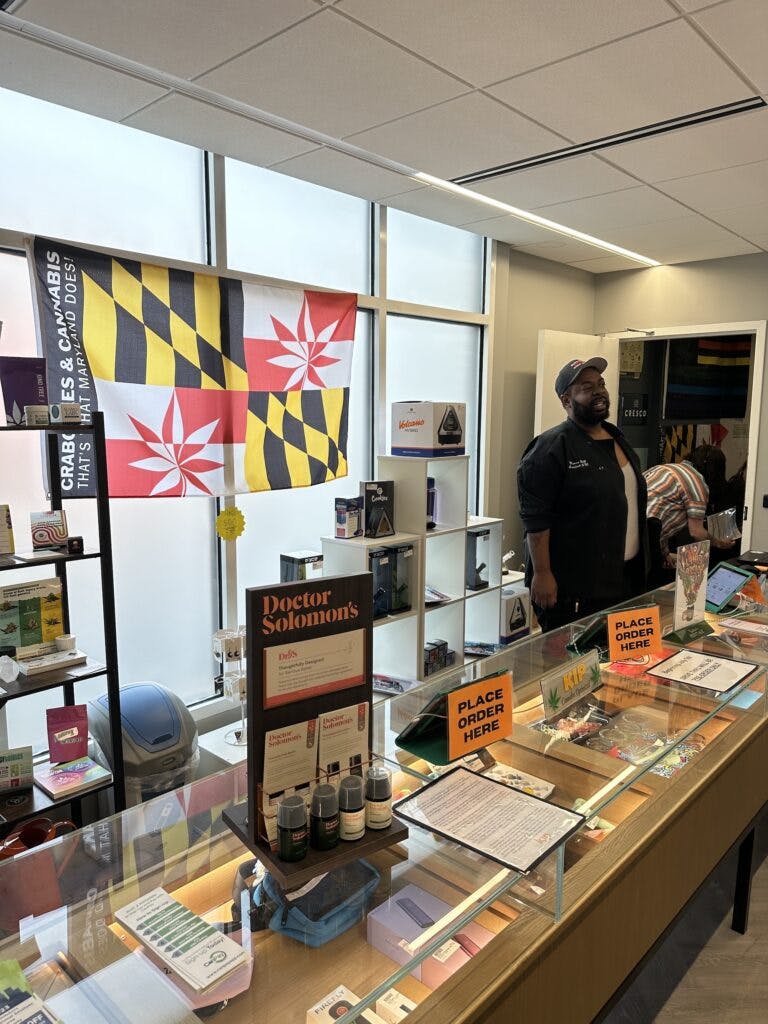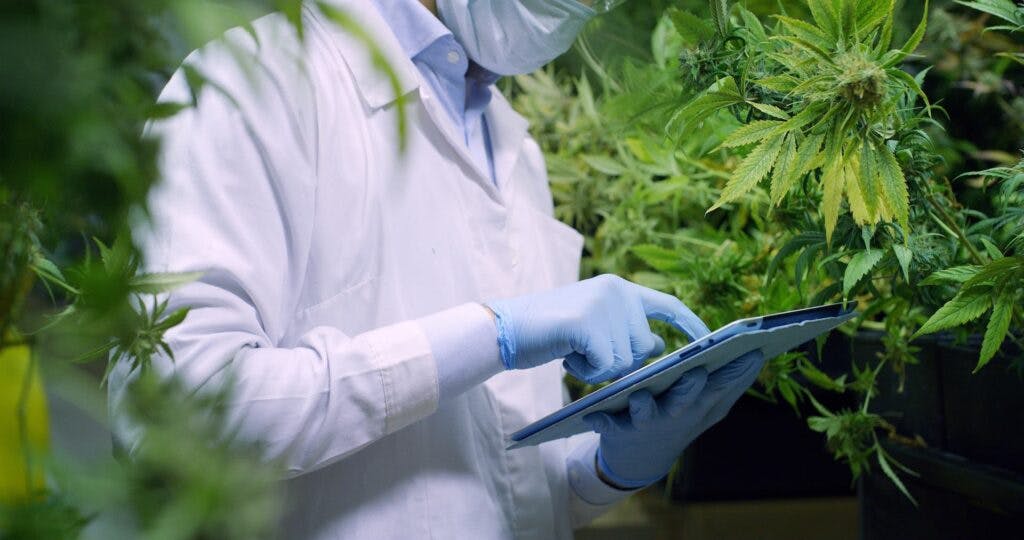[ad_1]
Maryland is looking pretty hazy, Leafly nation, and we don’t mean the weather. Over a month into adult-use sales, the Old Line state has seen a huge increase in demand for cannabis flower, prerolls, edibles and vapes. Between July 1 and July 30, data from Maryland’s Cannabis Administration shows sales totaled just under $85 million, double what the medical-only market raked in throughout June—on July 1 alone, total sales exceeded $4.5 million.
While medical patients appear to have stocked up in advance, Maryland was uniquely positioned for a bud boom. Surrounded by medical-only states or states with no form of legal cannabis, a holiday weekend, and a low 9% cannabis sales tax, Maryland has to contend with not only local demand, but an influx of out-of-towners and tourists who want to join in on the action. On Day 1, Leafly met a number of consumers who’d crossed multiple state borders, or just walked in from down the street. The common denominator is they wanted an accessible way to acquire quality cannabis and cannabis products.
… we’re selling out of our strains every week, and we have inventory rolling in for the next week right behind it.
Rebecca Bronfein Raphael, Chief Revenue Officer, Curio
“We steadily see more consumers coming through the door and the continued growth of cross-border purchasing and overarching curiosity in the different dosage forms. Flower, vapes, prerolls, and edibles continue to be the most popular product category,” says Curio’s Chief Revenue Officer, Rebecca Bronfein Raphael. “With respect to our flower supply, we’re selling out of our strains every week, and we have inventory rolling in for the next week right behind it. Our thesis about opening up our additional canopy and making sure that it was ready for the back half of 2023 was correct.”

No surprise, flower still reigns supreme for sales—the Washington Post reported that Maryland dispensaries sold over 19,500 pounds of cannabis in July, versus 8,000 in June. According to data from cannabis market data platform Headset, flower was about 50% of Maryland’s July dispensary sales, followed by vape pens. Prerolls saw the greatest increase in sales throughout the month relative to medical-only data, with a 172% jump. Some operators believe this has to do with new consumers, many of whom may have never visited a dispensary before, who want to sample strains and purchase smaller amounts before committing to an eighth.
Edibles and flower also saw big sales increases (138% and 145% respectively), while sales for concentrates, tinctures, and topicals appeared to drop. Part of this is consumer taste, and part is due to the fact that certain products, namely concentrates and infused prerolls, are still exclusive to medical patients.
Maryland currently has only 18 licensed cultivators to serve what is predicted to reach a billion-dollar state cannabis industry by 2025, but no need to fret. For months now, cultivators and manufacturers have been anticipating this increased demand, and scaling their supply accordingly. Operators told Leafly back in June that they had been setting aside additional inventory for months and ramping up operations, which has proved prudent.
Related
3 charming 85+ point Maryland flowers for summer 2023
Justin Garcia, compliance and public relations manager for SunMed Growers, the largest cultivator in Maryland, says their team have planned for adult-use as far back as 2015, when they received their license. They’ve increased their cultivation space multiple times over the years (now measuring nearly 300,000 square-feet), and launched their processing arm, SunMed Labs, to produce a range of concentrates, and most recently, edibles. Garcia estimates they have products in around 70 of Maryland’s dispensaries at any given time.
“All of our partners are telling us it’s anywhere between two to three times their business before adult use. That means more volume on their shelves and more volume that has to come out of our facility. In the future, we’d be positioned to be able to keep up with what is going to be anywhere from two, three, four times the demand, he says. “Our big limiting factor at this point is ‘how quickly can we package it?’’

Given the maturity of Maryland’s medical market, supply hasn’t been a major concern with operators that spoke with Leafly. Nearly 100 medical dispensaries in Maryland were able to convert their license type to adult-use in time for Day 1, which accounts for the huge jump in sales versus states like New Jersey, which opened with 12 dispensaries, or New York, with only one. Multistate operators like Curaleaf and TerrAscend with experience opening markets in other states said they scaled operations accordingly.
“To compare it to a typical Saturday, we had over a fivefold increase in sales for the day. And in the first month so far, we’ve doubled our sales; we’ve almost tripled the amount of customers that we continue to welcome into the Maryland market,” says Dinesh Penugonda, Curaleaf’s VIP of retail operations. “We invested ahead of the launch both from a capacity product supply standpoint, as well as in our facilities, to make sure that we were ready for the increased demand.”
Maryland as a state has some funky borders, and geography has proved to play a part in where consumers flock. Curio’s Baltimore County store, for example, has seen huge demand for gummies, whereas flower tops the list at their Elkton, MD, sister store. Chantelle Elsner, TerrAscend’s SVP of Commercial Operations, tells Leafly that their Cumberland store, which sits close to the border of West Virginia, saw significant growth in flower sales July with both adult-use consumers and medical patients, and an uptick in medical-only concentrates.
Related
The best rated weed dispensaries in Maryland for 2023
“Our strategic approach when we enter new states is to set up our cultivation to support the market demand. Maryland is a more mature market; the consumers understand the product. From my time spent on the ground with the teams when we launched on July 1, everyone was very well-educated about the products, about the form factors, and pretty in tune with pricing and assortment. Overall, we’ve been matching our supply with our demand and focusing on new products, such as concentrates or different types of prerolls, to drive further penetration into the greater wholesale market.”

The biggest challenges, many sources repeated to us, are the current emergency regulations’ constraints on cannabis marketing and demarcation of products and services that are still exclusive to medical patients. Curbside pickup, for example, is still exclusive to medical patients, as are dabbable products, high-potency edibles, and infused prerolls. Marketing regulations are more conservative than before, and updated SOPs have created additional steps in processing and packaging; if you’re seeing a dip in supply, it’s more likely due to supply chain compliance rather than a lack of inventory.
The Maryland Cannabis Administration will open applications for hundreds more licenses across the supply chain in September 2023, with specific criteria for social equity applicants, and Maryland’s current emergency regulations for cannabis expire June 30, 2024, leaving under a year for regulators to make changes. Elsner told Leafly that TerrAscend has been compiling data to present to regulators alongside other operators in favor of expanding access to concentrates to adult-use consumers based on their successful efforts in New Jersey.
Related
We shopped for Maryland’s best legal weed. Here’s how much it cost
Operators agree that Maryland’s transition has been swift, and the numbers are promising for continued industry growth and consistent access for customers and patients to their favorite products and strains. But many also point out that a bustling first month can’t reliably predict the rest of the year, nor how the influx of new dispensaries, cultivators, processors, and microbusinesses will impact the market in the coming years.
“What we don’t want to do is use one month of data as the crystal ball for the rest of time, said Raphael of Curio.
[ad_2]
Source link

